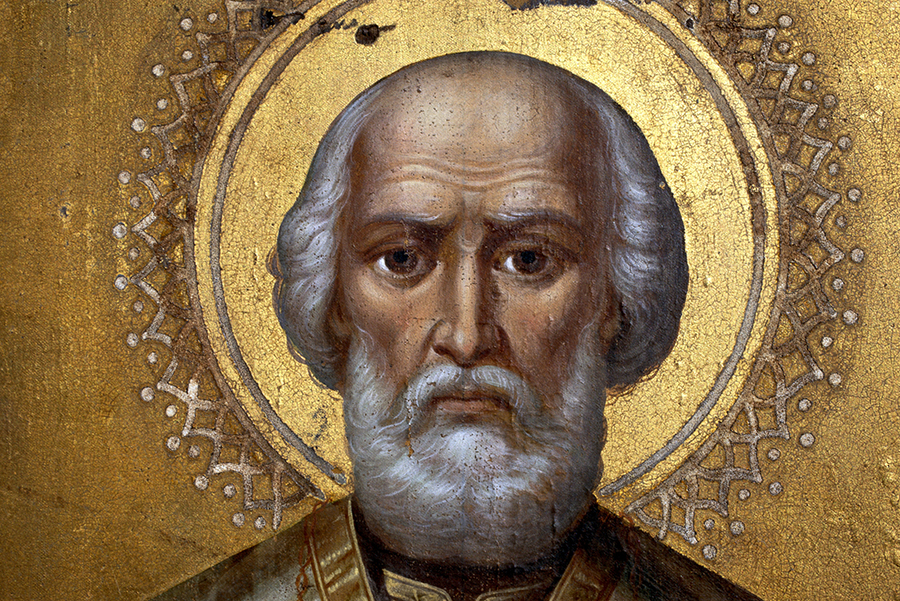THE LEGEND OF ST. NICHOLAS
圣•尼古拉斯的传说
The legend of Santa Claus can be traced back hundreds of years to a monk named St. Nicholas. It is believed that Nicholas was born sometime around 280 A.D. in Patara, near Myra in modern-day Turkey.
圣诞老人的传说可以追溯到几百年前,有一个主教叫圣•尼古拉斯,据认为他在公元280年左右出生在潘特拉(Patara),在现在土耳其的米拉附近。

Much admired for his piety and kindness, St. Nicholas became the subject of many legends. It is said that he gave away all of his inherited wealth and traveled the countryside helping the poor and sick. His feast day is celebrated on the anniversary of his death, December 6. This was traditionally considered a lucky day to make large purchases or to get married.由于虔诚和善良,他很受人爱戴,成为了很多传奇故事的主人公。据说他把继承的所有财产都分给了别人,到乡间各处救助穷人和病人。每年的12月6日是纪念他去世的日子,这一天在传统意义上被认为是买买买或结婚的吉日。
SINTER KLAAS COMES TO NEW YORK
SINTER KLAAS到纽约

St. Nicholas made his first inroads into American popular culture towards the end of the 18th century. The name Santa Claus evolved from Nick’s Dutch nickname, Sinter Klaas, a shortened form of Sint Nikolaas (Dutch for Saint Nicholas). In 1804, John Pintard, a member of the New York Historical Society, distributed woodcuts of St. Nicholas at the society’s annual meeting. The background of the engraving contains now-familiar Santa images including stockings filled with toys and fruit hung over a fireplace.
圣•尼古拉斯最初在18世纪末进入美国主流文化,“圣诞老人”这个词是从尼古拉斯的荷兰语中的昵称Sinter Klaas转变来的,是Sint Nikolaas(荷兰语的圣•尼古拉斯)的简称。1804年,纽约历史学会的John Pintard在学会的年会上分发了圣•尼古拉斯的木雕,雕刻的背景有现在人们熟知的圣诞老人的形象,包括挂在壁炉上面的装满玩具和水果的长筒袜。
Gift-giving, mainly centered around children, has been an important part of the Christmas celebration since the early 19th century. Stores began to advertise Christmas shopping in 1820.
从19世纪早期开始,以孩子为中心的赠送礼物行为开始成为圣诞节庆祝活动的主要部分。1820年,商场开始为圣诞购物打广告。
THE NIGHT BEFORE CHRISTMAS
圣诞节前夜

In 1822, Clement Clarke Moore, an Episcopal minister, wrote a long Christmas poem for his three daughters entitled “An Account of a Visit from St. Nicholas.” Moore’s poem is largely responsible for our modern image of Santa Claus as a “right jolly old elf” with a portly figure and the supernatural ability to ascend a chimney with a mere nod of his head! His poem helped popularize the now-familiar image of a Santa Claus who flew from house to house on Christmas Eve–in “a miniature sleigh” led by eight flying reindeer–leaving presents for deserving children. In 1881, political cartoonist Thomas Nast drew on Moore’s poem to create the first likeness that matches our modern image of Santa Claus. His cartoon depicted Santa as a rotund, cheerful man with a full, white beard, holding a sack laden with toys for lucky children.
1822年英国圣公会牧师Clement Clarke Moore为他三个女儿写了一首圣诞长诗“An Account of a Visit from St. Nicholas”,这首诗很大程度上决定了现代的圣诞老人形象——胖胖的“快乐老精灵”,微微颔首,有着攀爬烟囱的超能力!他的诗使现在熟知的圣诞老人形象家喻户晓——圣诞节前夜驾着8只会飞的驯鹿拉的小雪橇在房顶上飞来飞去,给该得到礼物的孩子们送礼物。1881年,政治漫画家Thomas Nast针对这首诗画了一幅漫画创作出了第一个和现代圣诞老人形象相似的人物。他把圣诞老人画成了一个长着白色大胡子的矮胖的快乐男人,拿着一个装满送给幸运孩子的玩具的袋子。
相关热点:
圣诞歌曲













